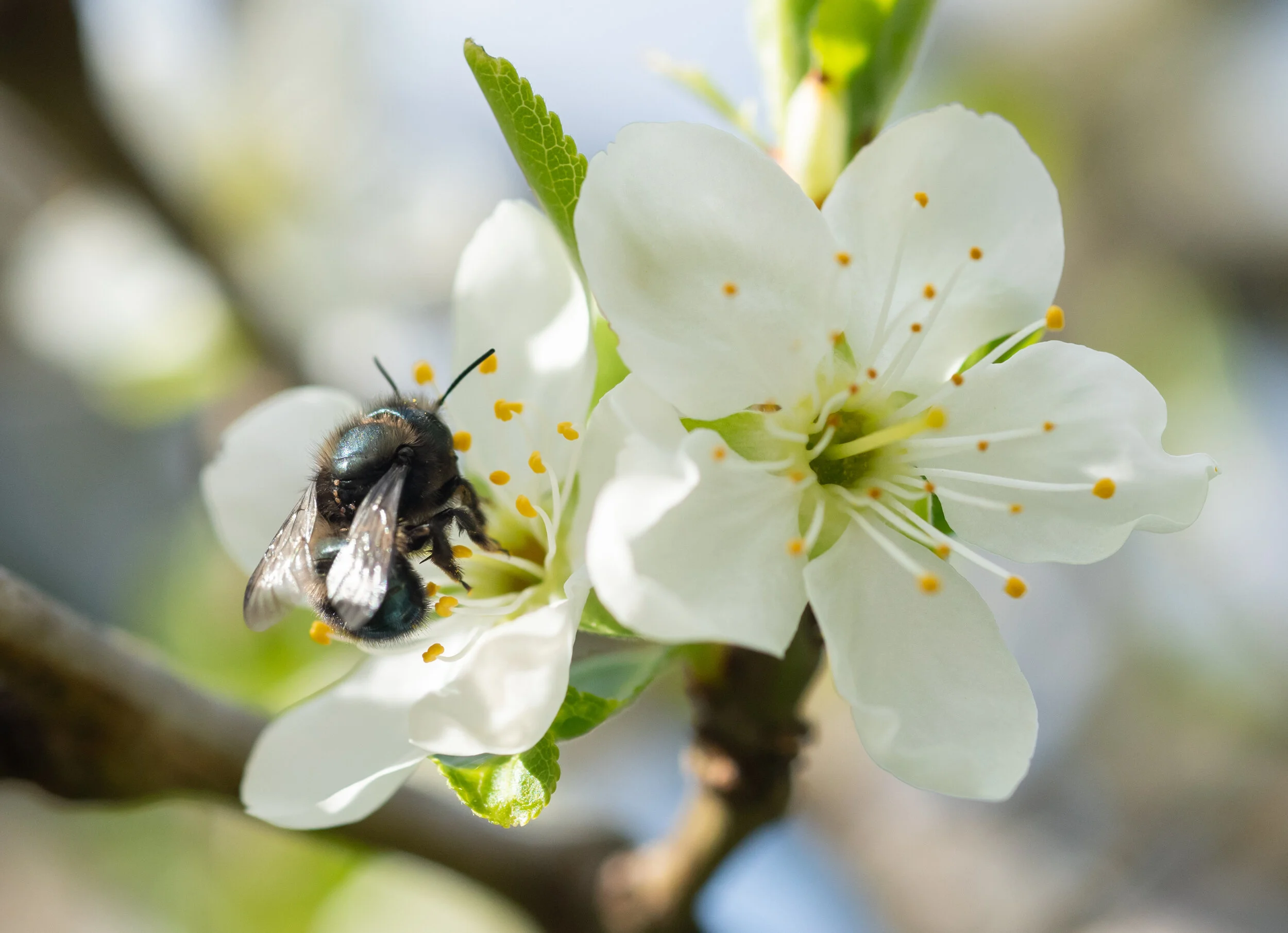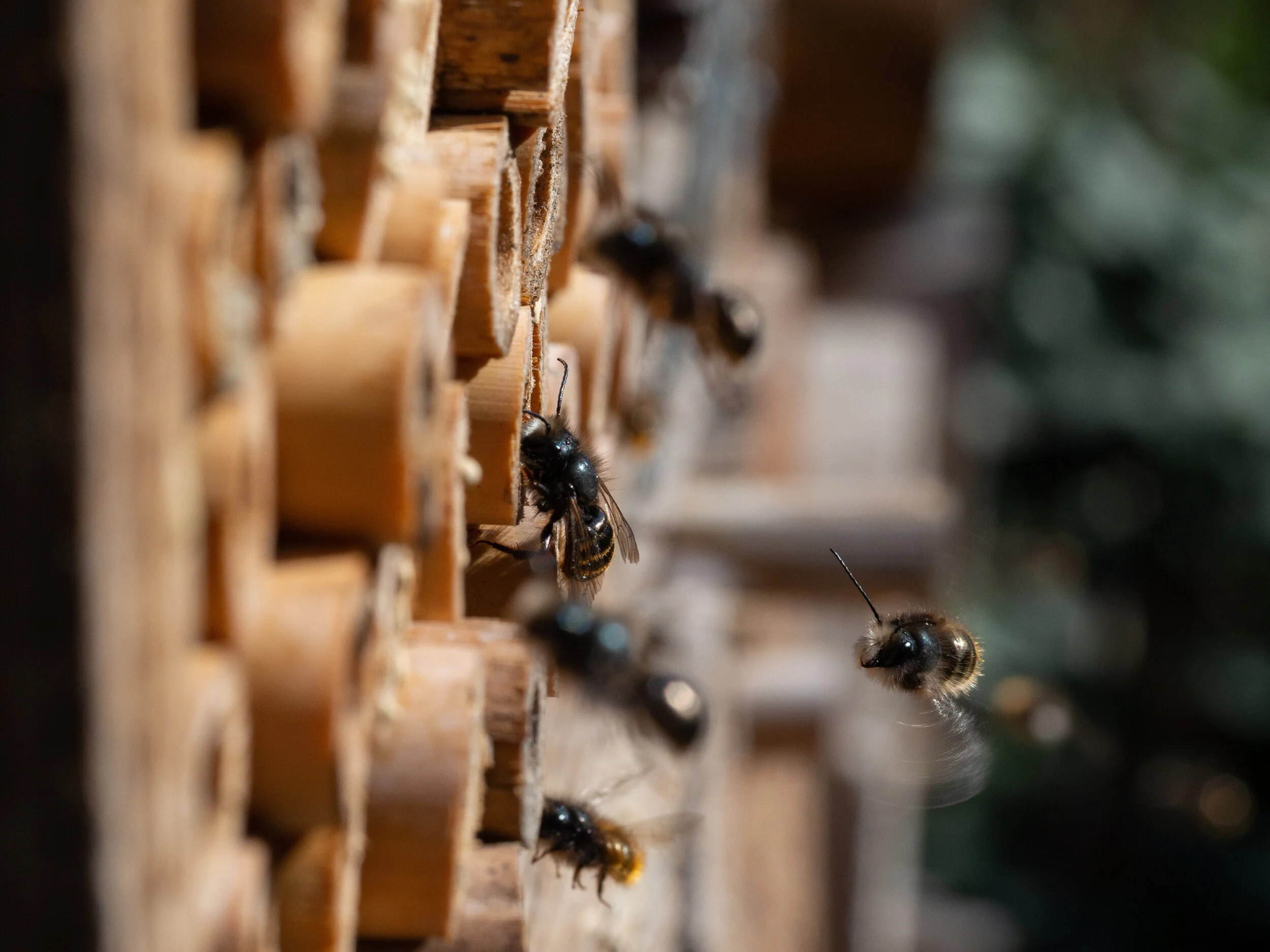The Buzz on the Orchard Mason Bee
Fruit trees will be awakening soon, and their blooming is the call to duty for mason bees. These bees are invaluable pollinators for early-blooming fruit and nut trees and have a fascinating lifecycle. The solitary animals are active in their adult stage for only a few weeks in the spring—a period of time that coincides with the blooming of fruit trees. They are much more effective at pollinating than honeybees, are non-destructive, rarely (if ever) sting, and are active even when temperatures are too cold for honeybees to brave.
Mason Bee Lifecycle
Adult Orchard Mason bees live only a few short weeks. In that time, they mate, gather food for their next generation of bees, lay eggs and die. Adult males hatch first, do a little foraging for nectar, and congregate around the nest site waiting for the females to emerge. As soon as the female bees appear, they will mate with a male and fly off to forage and wait for their newly fertilized eggs to develop. Males live only about 2 weeks, leaving the rest of the work to the females. The ladies begin their tasks by searching for suitable nesting sites, which are existing holes to accommodate the upcoming generation. Since mason bees do not excavate holes, they look for spaces about 1/4-3/8 inch in diameter and 6 inches deep. The female deposits an egg along with a cache of food for the larvae, and then ‘plasters’ a partition with mud to create a singular brooding quarter for each larva. She then repeats the process until the entire 6-inch tube is filled and capped with mud. That mud plastering construction technique earned these bees their ‘mason’ designation. Eggs are laid by gender, females first and males last, so males will be closest to the opening of the nesting hole and emerge first in spring. Females live 6-8 weeks, several weeks longer than the males, in order to complete the egg-laying process, after which, she dies. Shortly thereafter, the eggs hatch, the larvae consume the food in their chambers, and spin a cocoon. They pupate over the coming months and emerge as adult bees the following spring to repeat the process.
Mason Bees vs. Honeybees: A Comparison
Mason bees are native to the US, where honeybees are an imported animal. Masons are physically smaller than honeybees and lack the golden coloration. They are typically black or slightly metallic blue, giving them the appearance somewhere in between a honeybee and a housefly.
Another physical difference between these bees that leads to the pollination efficacy of masons over honeybees is their method of transporting pollen. Mason bees carry flower pollen on the hairs that cover the bottom of their bodies, where honeybees have pollen baskets on their hind legs. The pollen baskets provide a secure means to carry the payload without loss. Conversely, the pollen on a mason bee’s body is easily shed each time she visits a new flower, effectively moving and exchanging pollen between blooms. A female mason bee will visit 1600-2400 flowers each day, pollinating 97% of those blooms. That’s good pollination, especially when compared to the incidental exchange of pollen when a honeybee visits a flower.
The biggest distinction between the mason and honeybee is their social structures. As a solitary species, each mason bee must fend for itself and will never experience the organized system that honeybees have developed. Honeybees have a highly evolved, social system where teamwork and communication mean a division of labor and efficient production. They are very effective pollen and nectar harvesters, as scouts return to the hive to inform worker bees where the blossoms are. The workers go out en masse and strip the flowers of nectar and pollen for the community to use. Honeybees build structures of wax, fill them with honey that they have produced, and raise and care for the young that the queen bears—all as a unified community. Mason bees, on the other hand, must individually forage for food, build nests and lay eggs. There are no worker mason bees to do the heavy lifting, and each female mason bee is fertile—no queens here!
Emergence time of mason bees coincides with early fruit tree blooms, which oftentimes occurs when temperatures are too low for honeybees. Honeybees are most active when the weather warms, and they may miss some or all of the critical flowering period of especially early stone fruit trees.
Lending a Helping Hand: Supporting Mason Bee Populations
Providing clean, secure places for mason bees to nest, and locating them in the vicinity of fruit trees will go a long way to encouraging the bees to stick around and increase their numbers. There are a variety of housing systems that are suitable to mason bees. Single-use paper tubes and reusable wooden trays are two options we offer at Territorial Seed, but there are excellent homemade designs that can be found in various books or online.
Another key to success involves the gardener’s intervention during the bees’ pupal stage. Harvesting the cocoons and storing them in the refrigerator until it is time for the adults to emerge will keep the developing bees safe from predators, weather and disease. Freshly cleaned or new housing should be placed out at the same time and near the cocoons. The female bees will instinctively return to the location where they emerged to search for nesting sites and having ready housing close at hand saves them the effort of scouting.
Establishing and maintaining a mason bee population requires much less effort than keeping honeybees, and although you won’t reap the benefit of honey harvests, you will enjoy bountiful fruit from your home orchard trees as well as foster these diligent native pollinators.
Author: Kat B.
References:
Dr. Margriet Dogterom, Pollination with Mason Bees
Brian L. Griffin, The Orchard Mason Bee






